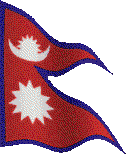 It was Gai Jatra, one of the other interesting festival, on August 29 2007. This festival is celebrated in the memories of the lost family member during the last year. The word Gai Jatra came from two words Gai (which means Cow) and Jatra (festival). It is also called Saparu in Newari language. The whole city streets are crowded with the parade of the families who have lost a member during the past year parade in a decorated cow around the city. Most of the people send a cow from their house and those who can't find a cow will send their kids dressed up as cows or ascetics and walk in procession along the festival route. Cow has a special place in the Hinduism. It is respected as a god and mostly a given the respect as to a mother. So this day, it is believed that the sacred animal helps departed souls to cross the cosmic ocean in their journey into the after-world.
It was Gai Jatra, one of the other interesting festival, on August 29 2007. This festival is celebrated in the memories of the lost family member during the last year. The word Gai Jatra came from two words Gai (which means Cow) and Jatra (festival). It is also called Saparu in Newari language. The whole city streets are crowded with the parade of the families who have lost a member during the past year parade in a decorated cow around the city. Most of the people send a cow from their house and those who can't find a cow will send their kids dressed up as cows or ascetics and walk in procession along the festival route. Cow has a special place in the Hinduism. It is respected as a god and mostly a given the respect as to a mother. So this day, it is believed that the sacred animal helps departed souls to cross the cosmic ocean in their journey into the after-world.


Humor is another side of the festival. Comic dramas and street shows making fun of government officials are performed. People also roam the city dressed up like lunatics. Newspapers bring out special "mad" editions. From ancient ages people are allowed to demonstrate any critics this day, even when autocracy ruled Nepal.
In Kathmandu, the bereaved families proceed alone the festival route individually whereas in Patan, the participants gather at Durbar Square and then move out together. In Kirtipur, the Jatra starts from the night. Almost every won't sleep at night and on the Gai Jatra night a buffalo is sacrificed outside the Bagh Bhairav Temple. So I felt the Jatra as if it was a night-time Jatra.



The celebration in Bhaktapur is the most interesting one and I personally prefer going there if you want to see the true demonstration of Gai Jatra where there are tall bamboo poles, wrapped in cloth, and toped with horns fashioned of straw are carried around the city in memory of the dead. It seems like the whole city is taking part and all the city streets will be filled with the parade. It might be due to the narrowed streets there but all the city streets are found full on that day.






